Essay on Gender Equality and Community Services in Australia, INT101
VerifiedAdded on 2022/09/06
|7
|2243
|9
Essay
AI Summary
This essay provides a comprehensive analysis of gender equality within the context of Australian community services. It begins by defining gender equality and its significance, highlighting the persistent gender gap in the Australian workforce and its implications, such as wage disparities and limited career advancement opportunities for women. The essay then delves into historical events and trends, including the evolution of legislation like the Disability Discrimination Act (DDA) of 1992, and the impact of social policies and acts like the Workplace Gender Equality Act 2012 and the Australian Public Service Gender Equality Strategy. It also examines the role of the Australian government and various agencies in promoting gender equality, including the Workplace Gender Equality Agency (WGEA) and the Employer of Choice for Gender Equality (EOCGE) citation. Furthermore, the essay discusses current ethical and legislative requirements, emphasizing the importance of gender equality for economic performance and organizational success. The essay concludes by emphasizing that societies can achieve higher levels of output and improved well-being by ensuring equal opportunities for both genders. It draws on multiple peer-reviewed journal articles and textbook references to support its arguments.

Introduction to community services
Paraphrase This Document
Need a fresh take? Get an instant paraphrase of this document with our AI Paraphraser
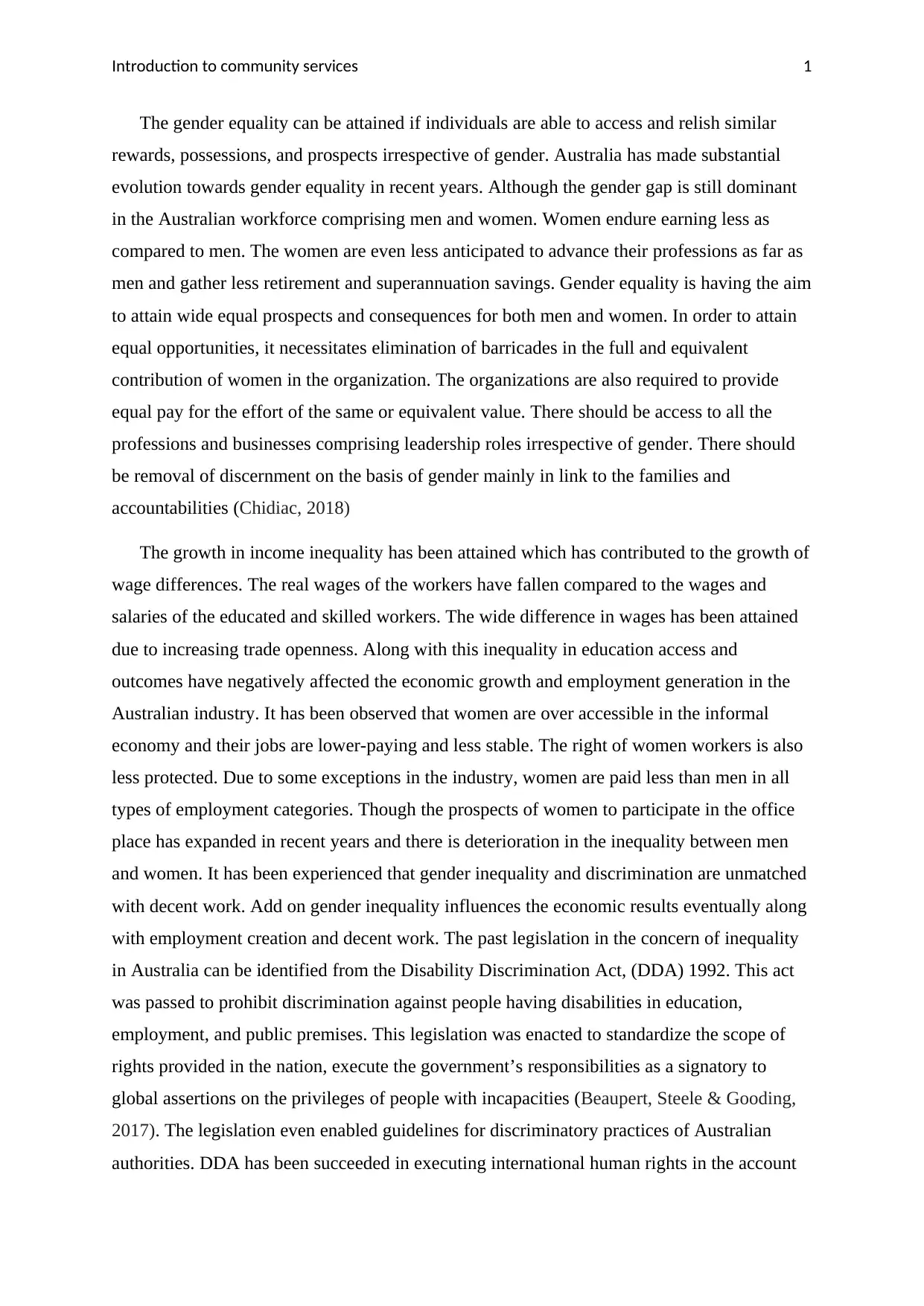
Introduction to community services 1
The gender equality can be attained if individuals are able to access and relish similar
rewards, possessions, and prospects irrespective of gender. Australia has made substantial
evolution towards gender equality in recent years. Although the gender gap is still dominant
in the Australian workforce comprising men and women. Women endure earning less as
compared to men. The women are even less anticipated to advance their professions as far as
men and gather less retirement and superannuation savings. Gender equality is having the aim
to attain wide equal prospects and consequences for both men and women. In order to attain
equal opportunities, it necessitates elimination of barricades in the full and equivalent
contribution of women in the organization. The organizations are also required to provide
equal pay for the effort of the same or equivalent value. There should be access to all the
professions and businesses comprising leadership roles irrespective of gender. There should
be removal of discernment on the basis of gender mainly in link to the families and
accountabilities (Chidiac, 2018)
The growth in income inequality has been attained which has contributed to the growth of
wage differences. The real wages of the workers have fallen compared to the wages and
salaries of the educated and skilled workers. The wide difference in wages has been attained
due to increasing trade openness. Along with this inequality in education access and
outcomes have negatively affected the economic growth and employment generation in the
Australian industry. It has been observed that women are over accessible in the informal
economy and their jobs are lower-paying and less stable. The right of women workers is also
less protected. Due to some exceptions in the industry, women are paid less than men in all
types of employment categories. Though the prospects of women to participate in the office
place has expanded in recent years and there is deterioration in the inequality between men
and women. It has been experienced that gender inequality and discrimination are unmatched
with decent work. Add on gender inequality influences the economic results eventually along
with employment creation and decent work. The past legislation in the concern of inequality
in Australia can be identified from the Disability Discrimination Act, (DDA) 1992. This act
was passed to prohibit discrimination against people having disabilities in education,
employment, and public premises. This legislation was enacted to standardize the scope of
rights provided in the nation, execute the government’s responsibilities as a signatory to
global assertions on the privileges of people with incapacities (Beaupert, Steele & Gooding,
2017). The legislation even enabled guidelines for discriminatory practices of Australian
authorities. DDA has been succeeded in executing international human rights in the account
The gender equality can be attained if individuals are able to access and relish similar
rewards, possessions, and prospects irrespective of gender. Australia has made substantial
evolution towards gender equality in recent years. Although the gender gap is still dominant
in the Australian workforce comprising men and women. Women endure earning less as
compared to men. The women are even less anticipated to advance their professions as far as
men and gather less retirement and superannuation savings. Gender equality is having the aim
to attain wide equal prospects and consequences for both men and women. In order to attain
equal opportunities, it necessitates elimination of barricades in the full and equivalent
contribution of women in the organization. The organizations are also required to provide
equal pay for the effort of the same or equivalent value. There should be access to all the
professions and businesses comprising leadership roles irrespective of gender. There should
be removal of discernment on the basis of gender mainly in link to the families and
accountabilities (Chidiac, 2018)
The growth in income inequality has been attained which has contributed to the growth of
wage differences. The real wages of the workers have fallen compared to the wages and
salaries of the educated and skilled workers. The wide difference in wages has been attained
due to increasing trade openness. Along with this inequality in education access and
outcomes have negatively affected the economic growth and employment generation in the
Australian industry. It has been observed that women are over accessible in the informal
economy and their jobs are lower-paying and less stable. The right of women workers is also
less protected. Due to some exceptions in the industry, women are paid less than men in all
types of employment categories. Though the prospects of women to participate in the office
place has expanded in recent years and there is deterioration in the inequality between men
and women. It has been experienced that gender inequality and discrimination are unmatched
with decent work. Add on gender inequality influences the economic results eventually along
with employment creation and decent work. The past legislation in the concern of inequality
in Australia can be identified from the Disability Discrimination Act, (DDA) 1992. This act
was passed to prohibit discrimination against people having disabilities in education,
employment, and public premises. This legislation was enacted to standardize the scope of
rights provided in the nation, execute the government’s responsibilities as a signatory to
global assertions on the privileges of people with incapacities (Beaupert, Steele & Gooding,
2017). The legislation even enabled guidelines for discriminatory practices of Australian
authorities. DDA has been succeeded in executing international human rights in the account
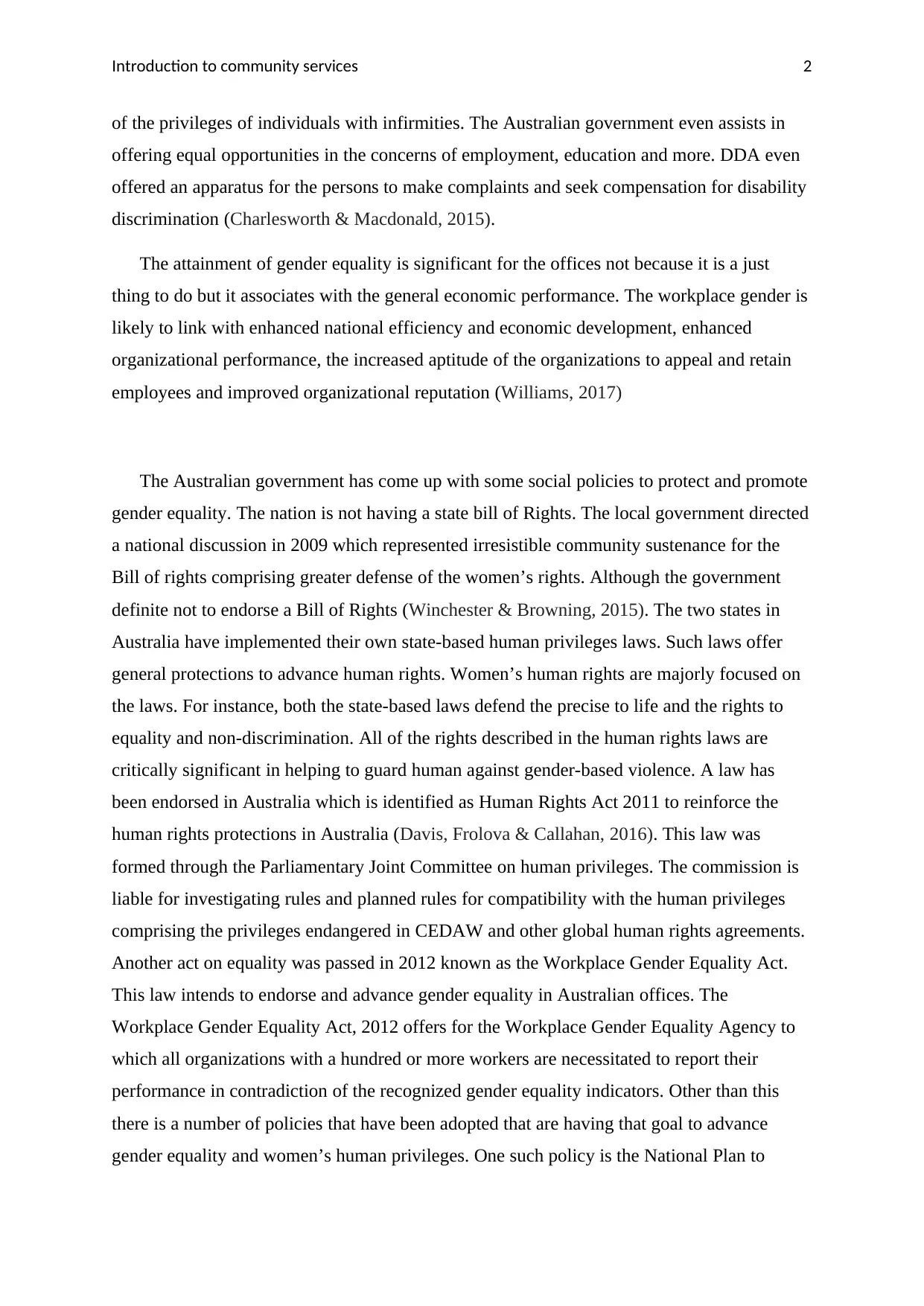
Introduction to community services 2
of the privileges of individuals with infirmities. The Australian government even assists in
offering equal opportunities in the concerns of employment, education and more. DDA even
offered an apparatus for the persons to make complaints and seek compensation for disability
discrimination (Charlesworth & Macdonald, 2015).
The attainment of gender equality is significant for the offices not because it is a just
thing to do but it associates with the general economic performance. The workplace gender is
likely to link with enhanced national efficiency and economic development, enhanced
organizational performance, the increased aptitude of the organizations to appeal and retain
employees and improved organizational reputation (Williams, 2017)
The Australian government has come up with some social policies to protect and promote
gender equality. The nation is not having a state bill of Rights. The local government directed
a national discussion in 2009 which represented irresistible community sustenance for the
Bill of rights comprising greater defense of the women’s rights. Although the government
definite not to endorse a Bill of Rights (Winchester & Browning, 2015). The two states in
Australia have implemented their own state-based human privileges laws. Such laws offer
general protections to advance human rights. Women’s human rights are majorly focused on
the laws. For instance, both the state-based laws defend the precise to life and the rights to
equality and non-discrimination. All of the rights described in the human rights laws are
critically significant in helping to guard human against gender-based violence. A law has
been endorsed in Australia which is identified as Human Rights Act 2011 to reinforce the
human rights protections in Australia (Davis, Frolova & Callahan, 2016). This law was
formed through the Parliamentary Joint Committee on human privileges. The commission is
liable for investigating rules and planned rules for compatibility with the human privileges
comprising the privileges endangered in CEDAW and other global human rights agreements.
Another act on equality was passed in 2012 known as the Workplace Gender Equality Act.
This law intends to endorse and advance gender equality in Australian offices. The
Workplace Gender Equality Act, 2012 offers for the Workplace Gender Equality Agency to
which all organizations with a hundred or more workers are necessitated to report their
performance in contradiction of the recognized gender equality indicators. Other than this
there is a number of policies that have been adopted that are having that goal to advance
gender equality and women’s human privileges. One such policy is the National Plan to
of the privileges of individuals with infirmities. The Australian government even assists in
offering equal opportunities in the concerns of employment, education and more. DDA even
offered an apparatus for the persons to make complaints and seek compensation for disability
discrimination (Charlesworth & Macdonald, 2015).
The attainment of gender equality is significant for the offices not because it is a just
thing to do but it associates with the general economic performance. The workplace gender is
likely to link with enhanced national efficiency and economic development, enhanced
organizational performance, the increased aptitude of the organizations to appeal and retain
employees and improved organizational reputation (Williams, 2017)
The Australian government has come up with some social policies to protect and promote
gender equality. The nation is not having a state bill of Rights. The local government directed
a national discussion in 2009 which represented irresistible community sustenance for the
Bill of rights comprising greater defense of the women’s rights. Although the government
definite not to endorse a Bill of Rights (Winchester & Browning, 2015). The two states in
Australia have implemented their own state-based human privileges laws. Such laws offer
general protections to advance human rights. Women’s human rights are majorly focused on
the laws. For instance, both the state-based laws defend the precise to life and the rights to
equality and non-discrimination. All of the rights described in the human rights laws are
critically significant in helping to guard human against gender-based violence. A law has
been endorsed in Australia which is identified as Human Rights Act 2011 to reinforce the
human rights protections in Australia (Davis, Frolova & Callahan, 2016). This law was
formed through the Parliamentary Joint Committee on human privileges. The commission is
liable for investigating rules and planned rules for compatibility with the human privileges
comprising the privileges endangered in CEDAW and other global human rights agreements.
Another act on equality was passed in 2012 known as the Workplace Gender Equality Act.
This law intends to endorse and advance gender equality in Australian offices. The
Workplace Gender Equality Act, 2012 offers for the Workplace Gender Equality Agency to
which all organizations with a hundred or more workers are necessitated to report their
performance in contradiction of the recognized gender equality indicators. Other than this
there is a number of policies that have been adopted that are having that goal to advance
gender equality and women’s human privileges. One such policy is the National Plan to
⊘ This is a preview!⊘
Do you want full access?
Subscribe today to unlock all pages.

Trusted by 1+ million students worldwide
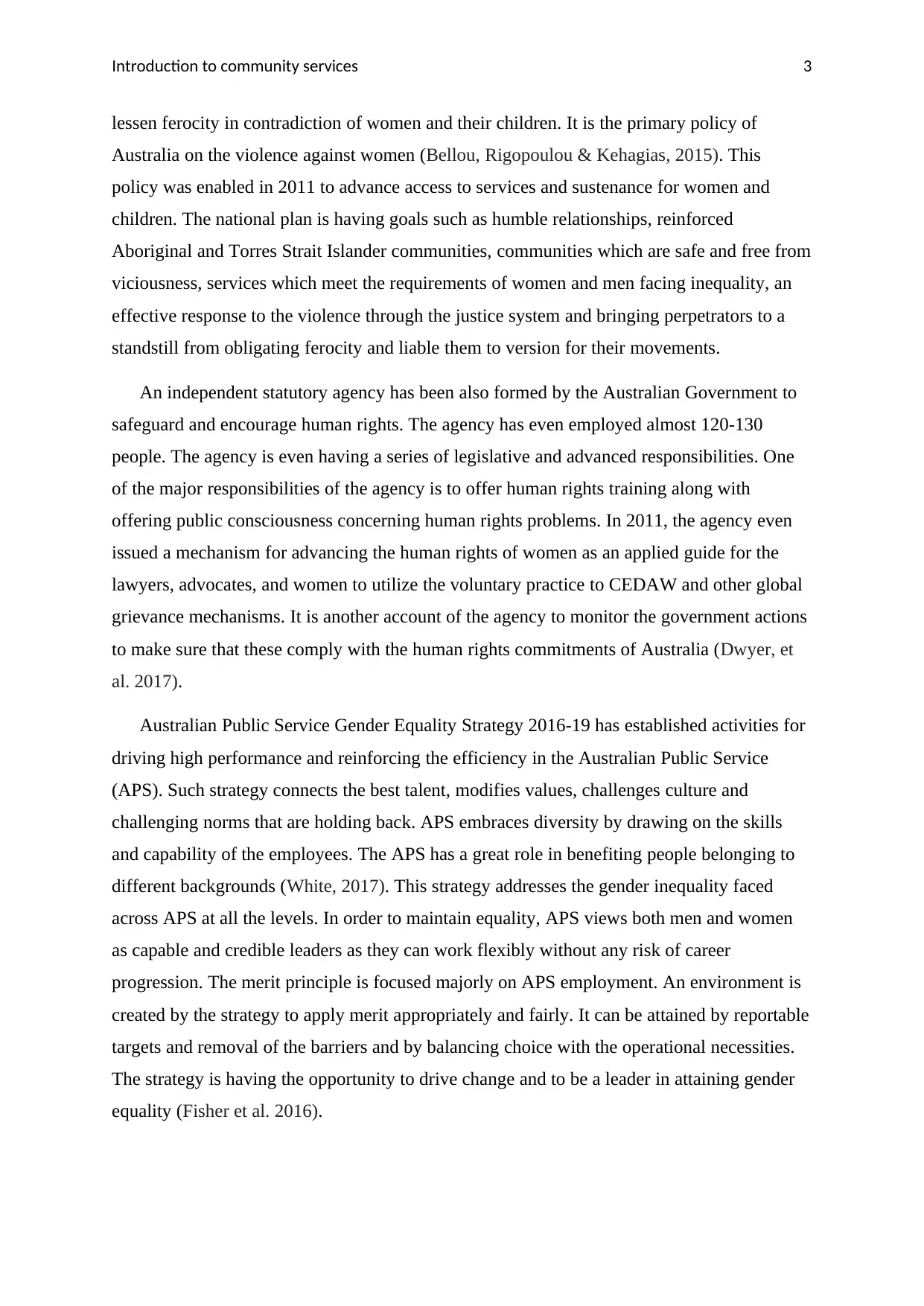
Introduction to community services 3
lessen ferocity in contradiction of women and their children. It is the primary policy of
Australia on the violence against women (Bellou, Rigopoulou & Kehagias, 2015). This
policy was enabled in 2011 to advance access to services and sustenance for women and
children. The national plan is having goals such as humble relationships, reinforced
Aboriginal and Torres Strait Islander communities, communities which are safe and free from
viciousness, services which meet the requirements of women and men facing inequality, an
effective response to the violence through the justice system and bringing perpetrators to a
standstill from obligating ferocity and liable them to version for their movements.
An independent statutory agency has been also formed by the Australian Government to
safeguard and encourage human rights. The agency has even employed almost 120-130
people. The agency is even having a series of legislative and advanced responsibilities. One
of the major responsibilities of the agency is to offer human rights training along with
offering public consciousness concerning human rights problems. In 2011, the agency even
issued a mechanism for advancing the human rights of women as an applied guide for the
lawyers, advocates, and women to utilize the voluntary practice to CEDAW and other global
grievance mechanisms. It is another account of the agency to monitor the government actions
to make sure that these comply with the human rights commitments of Australia (Dwyer, et
al. 2017).
Australian Public Service Gender Equality Strategy 2016-19 has established activities for
driving high performance and reinforcing the efficiency in the Australian Public Service
(APS). Such strategy connects the best talent, modifies values, challenges culture and
challenging norms that are holding back. APS embraces diversity by drawing on the skills
and capability of the employees. The APS has a great role in benefiting people belonging to
different backgrounds (White, 2017). This strategy addresses the gender inequality faced
across APS at all the levels. In order to maintain equality, APS views both men and women
as capable and credible leaders as they can work flexibly without any risk of career
progression. The merit principle is focused majorly on APS employment. An environment is
created by the strategy to apply merit appropriately and fairly. It can be attained by reportable
targets and removal of the barriers and by balancing choice with the operational necessities.
The strategy is having the opportunity to drive change and to be a leader in attaining gender
equality (Fisher et al. 2016).
lessen ferocity in contradiction of women and their children. It is the primary policy of
Australia on the violence against women (Bellou, Rigopoulou & Kehagias, 2015). This
policy was enabled in 2011 to advance access to services and sustenance for women and
children. The national plan is having goals such as humble relationships, reinforced
Aboriginal and Torres Strait Islander communities, communities which are safe and free from
viciousness, services which meet the requirements of women and men facing inequality, an
effective response to the violence through the justice system and bringing perpetrators to a
standstill from obligating ferocity and liable them to version for their movements.
An independent statutory agency has been also formed by the Australian Government to
safeguard and encourage human rights. The agency has even employed almost 120-130
people. The agency is even having a series of legislative and advanced responsibilities. One
of the major responsibilities of the agency is to offer human rights training along with
offering public consciousness concerning human rights problems. In 2011, the agency even
issued a mechanism for advancing the human rights of women as an applied guide for the
lawyers, advocates, and women to utilize the voluntary practice to CEDAW and other global
grievance mechanisms. It is another account of the agency to monitor the government actions
to make sure that these comply with the human rights commitments of Australia (Dwyer, et
al. 2017).
Australian Public Service Gender Equality Strategy 2016-19 has established activities for
driving high performance and reinforcing the efficiency in the Australian Public Service
(APS). Such strategy connects the best talent, modifies values, challenges culture and
challenging norms that are holding back. APS embraces diversity by drawing on the skills
and capability of the employees. The APS has a great role in benefiting people belonging to
different backgrounds (White, 2017). This strategy addresses the gender inequality faced
across APS at all the levels. In order to maintain equality, APS views both men and women
as capable and credible leaders as they can work flexibly without any risk of career
progression. The merit principle is focused majorly on APS employment. An environment is
created by the strategy to apply merit appropriately and fairly. It can be attained by reportable
targets and removal of the barriers and by balancing choice with the operational necessities.
The strategy is having the opportunity to drive change and to be a leader in attaining gender
equality (Fisher et al. 2016).
Paraphrase This Document
Need a fresh take? Get an instant paraphrase of this document with our AI Paraphraser
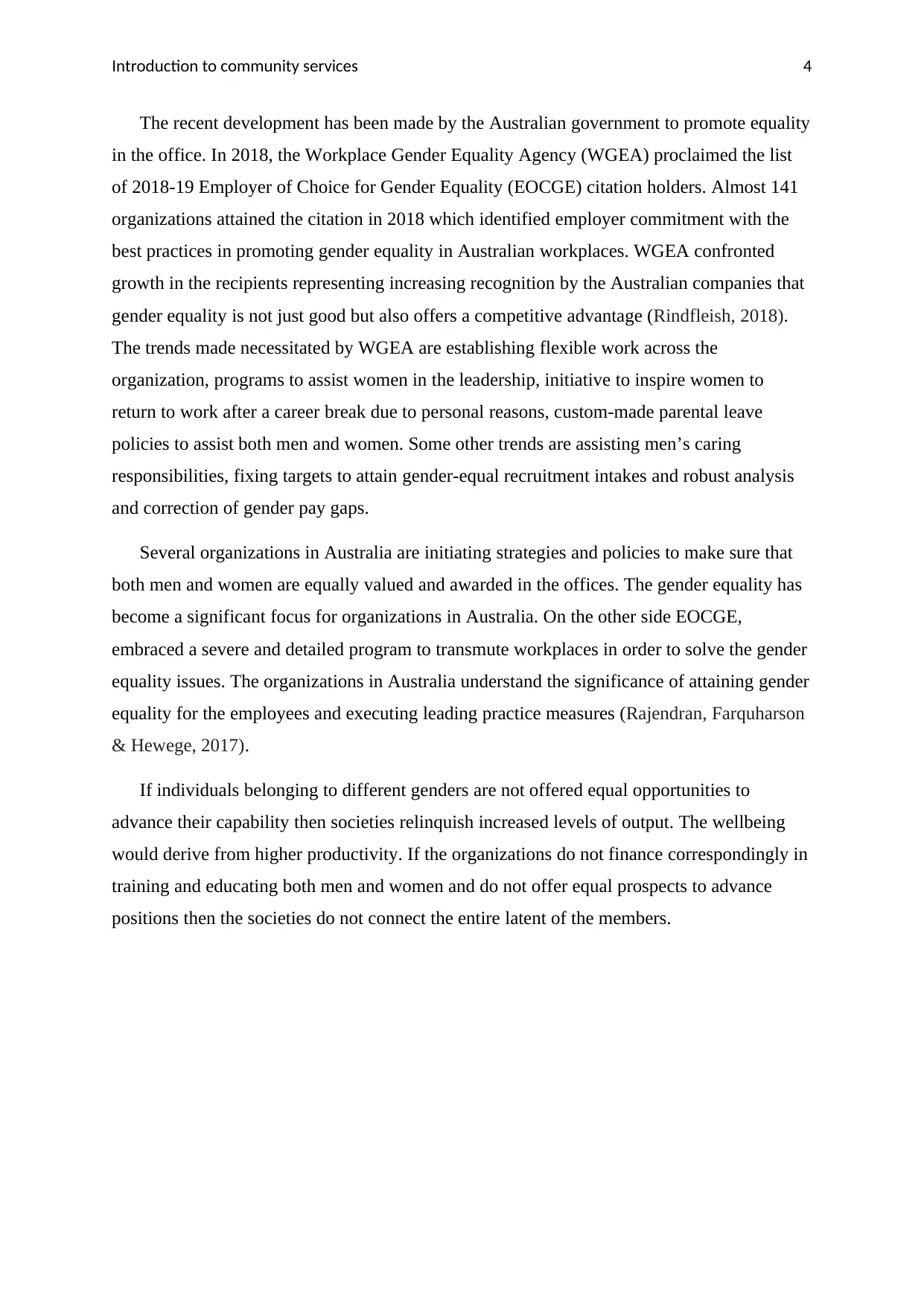
Introduction to community services 4
The recent development has been made by the Australian government to promote equality
in the office. In 2018, the Workplace Gender Equality Agency (WGEA) proclaimed the list
of 2018-19 Employer of Choice for Gender Equality (EOCGE) citation holders. Almost 141
organizations attained the citation in 2018 which identified employer commitment with the
best practices in promoting gender equality in Australian workplaces. WGEA confronted
growth in the recipients representing increasing recognition by the Australian companies that
gender equality is not just good but also offers a competitive advantage (Rindfleish, 2018).
The trends made necessitated by WGEA are establishing flexible work across the
organization, programs to assist women in the leadership, initiative to inspire women to
return to work after a career break due to personal reasons, custom-made parental leave
policies to assist both men and women. Some other trends are assisting men’s caring
responsibilities, fixing targets to attain gender-equal recruitment intakes and robust analysis
and correction of gender pay gaps.
Several organizations in Australia are initiating strategies and policies to make sure that
both men and women are equally valued and awarded in the offices. The gender equality has
become a significant focus for organizations in Australia. On the other side EOCGE,
embraced a severe and detailed program to transmute workplaces in order to solve the gender
equality issues. The organizations in Australia understand the significance of attaining gender
equality for the employees and executing leading practice measures (Rajendran, Farquharson
& Hewege, 2017).
If individuals belonging to different genders are not offered equal opportunities to
advance their capability then societies relinquish increased levels of output. The wellbeing
would derive from higher productivity. If the organizations do not finance correspondingly in
training and educating both men and women and do not offer equal prospects to advance
positions then the societies do not connect the entire latent of the members.
The recent development has been made by the Australian government to promote equality
in the office. In 2018, the Workplace Gender Equality Agency (WGEA) proclaimed the list
of 2018-19 Employer of Choice for Gender Equality (EOCGE) citation holders. Almost 141
organizations attained the citation in 2018 which identified employer commitment with the
best practices in promoting gender equality in Australian workplaces. WGEA confronted
growth in the recipients representing increasing recognition by the Australian companies that
gender equality is not just good but also offers a competitive advantage (Rindfleish, 2018).
The trends made necessitated by WGEA are establishing flexible work across the
organization, programs to assist women in the leadership, initiative to inspire women to
return to work after a career break due to personal reasons, custom-made parental leave
policies to assist both men and women. Some other trends are assisting men’s caring
responsibilities, fixing targets to attain gender-equal recruitment intakes and robust analysis
and correction of gender pay gaps.
Several organizations in Australia are initiating strategies and policies to make sure that
both men and women are equally valued and awarded in the offices. The gender equality has
become a significant focus for organizations in Australia. On the other side EOCGE,
embraced a severe and detailed program to transmute workplaces in order to solve the gender
equality issues. The organizations in Australia understand the significance of attaining gender
equality for the employees and executing leading practice measures (Rajendran, Farquharson
& Hewege, 2017).
If individuals belonging to different genders are not offered equal opportunities to
advance their capability then societies relinquish increased levels of output. The wellbeing
would derive from higher productivity. If the organizations do not finance correspondingly in
training and educating both men and women and do not offer equal prospects to advance
positions then the societies do not connect the entire latent of the members.
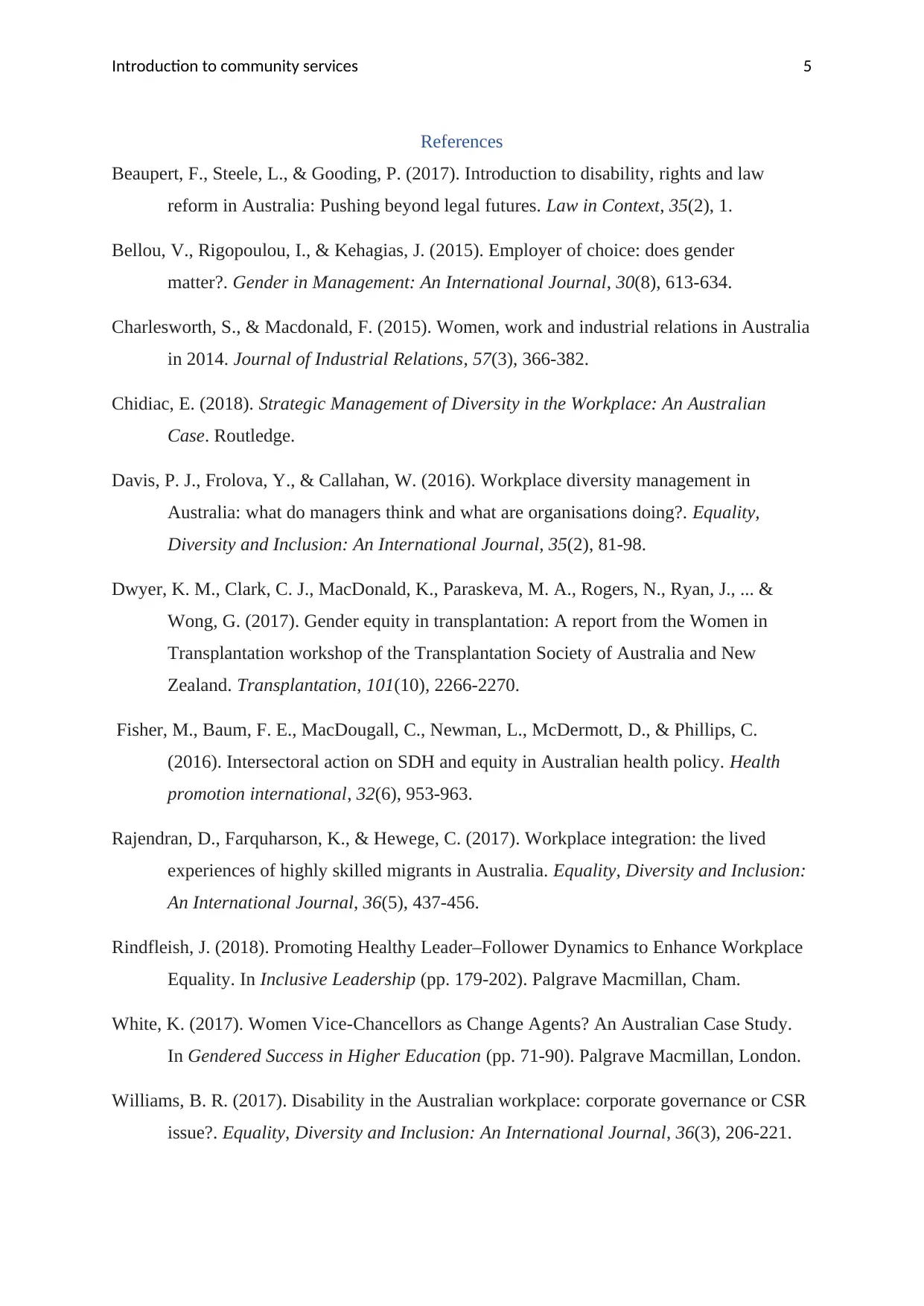
Introduction to community services 5
References
Beaupert, F., Steele, L., & Gooding, P. (2017). Introduction to disability, rights and law
reform in Australia: Pushing beyond legal futures. Law in Context, 35(2), 1.
Bellou, V., Rigopoulou, I., & Kehagias, J. (2015). Employer of choice: does gender
matter?. Gender in Management: An International Journal, 30(8), 613-634.
Charlesworth, S., & Macdonald, F. (2015). Women, work and industrial relations in Australia
in 2014. Journal of Industrial Relations, 57(3), 366-382.
Chidiac, E. (2018). Strategic Management of Diversity in the Workplace: An Australian
Case. Routledge.
Davis, P. J., Frolova, Y., & Callahan, W. (2016). Workplace diversity management in
Australia: what do managers think and what are organisations doing?. Equality,
Diversity and Inclusion: An International Journal, 35(2), 81-98.
Dwyer, K. M., Clark, C. J., MacDonald, K., Paraskeva, M. A., Rogers, N., Ryan, J., ... &
Wong, G. (2017). Gender equity in transplantation: A report from the Women in
Transplantation workshop of the Transplantation Society of Australia and New
Zealand. Transplantation, 101(10), 2266-2270.
Fisher, M., Baum, F. E., MacDougall, C., Newman, L., McDermott, D., & Phillips, C.
(2016). Intersectoral action on SDH and equity in Australian health policy. Health
promotion international, 32(6), 953-963.
Rajendran, D., Farquharson, K., & Hewege, C. (2017). Workplace integration: the lived
experiences of highly skilled migrants in Australia. Equality, Diversity and Inclusion:
An International Journal, 36(5), 437-456.
Rindfleish, J. (2018). Promoting Healthy Leader–Follower Dynamics to Enhance Workplace
Equality. In Inclusive Leadership (pp. 179-202). Palgrave Macmillan, Cham.
White, K. (2017). Women Vice-Chancellors as Change Agents? An Australian Case Study.
In Gendered Success in Higher Education (pp. 71-90). Palgrave Macmillan, London.
Williams, B. R. (2017). Disability in the Australian workplace: corporate governance or CSR
issue?. Equality, Diversity and Inclusion: An International Journal, 36(3), 206-221.
References
Beaupert, F., Steele, L., & Gooding, P. (2017). Introduction to disability, rights and law
reform in Australia: Pushing beyond legal futures. Law in Context, 35(2), 1.
Bellou, V., Rigopoulou, I., & Kehagias, J. (2015). Employer of choice: does gender
matter?. Gender in Management: An International Journal, 30(8), 613-634.
Charlesworth, S., & Macdonald, F. (2015). Women, work and industrial relations in Australia
in 2014. Journal of Industrial Relations, 57(3), 366-382.
Chidiac, E. (2018). Strategic Management of Diversity in the Workplace: An Australian
Case. Routledge.
Davis, P. J., Frolova, Y., & Callahan, W. (2016). Workplace diversity management in
Australia: what do managers think and what are organisations doing?. Equality,
Diversity and Inclusion: An International Journal, 35(2), 81-98.
Dwyer, K. M., Clark, C. J., MacDonald, K., Paraskeva, M. A., Rogers, N., Ryan, J., ... &
Wong, G. (2017). Gender equity in transplantation: A report from the Women in
Transplantation workshop of the Transplantation Society of Australia and New
Zealand. Transplantation, 101(10), 2266-2270.
Fisher, M., Baum, F. E., MacDougall, C., Newman, L., McDermott, D., & Phillips, C.
(2016). Intersectoral action on SDH and equity in Australian health policy. Health
promotion international, 32(6), 953-963.
Rajendran, D., Farquharson, K., & Hewege, C. (2017). Workplace integration: the lived
experiences of highly skilled migrants in Australia. Equality, Diversity and Inclusion:
An International Journal, 36(5), 437-456.
Rindfleish, J. (2018). Promoting Healthy Leader–Follower Dynamics to Enhance Workplace
Equality. In Inclusive Leadership (pp. 179-202). Palgrave Macmillan, Cham.
White, K. (2017). Women Vice-Chancellors as Change Agents? An Australian Case Study.
In Gendered Success in Higher Education (pp. 71-90). Palgrave Macmillan, London.
Williams, B. R. (2017). Disability in the Australian workplace: corporate governance or CSR
issue?. Equality, Diversity and Inclusion: An International Journal, 36(3), 206-221.
⊘ This is a preview!⊘
Do you want full access?
Subscribe today to unlock all pages.

Trusted by 1+ million students worldwide
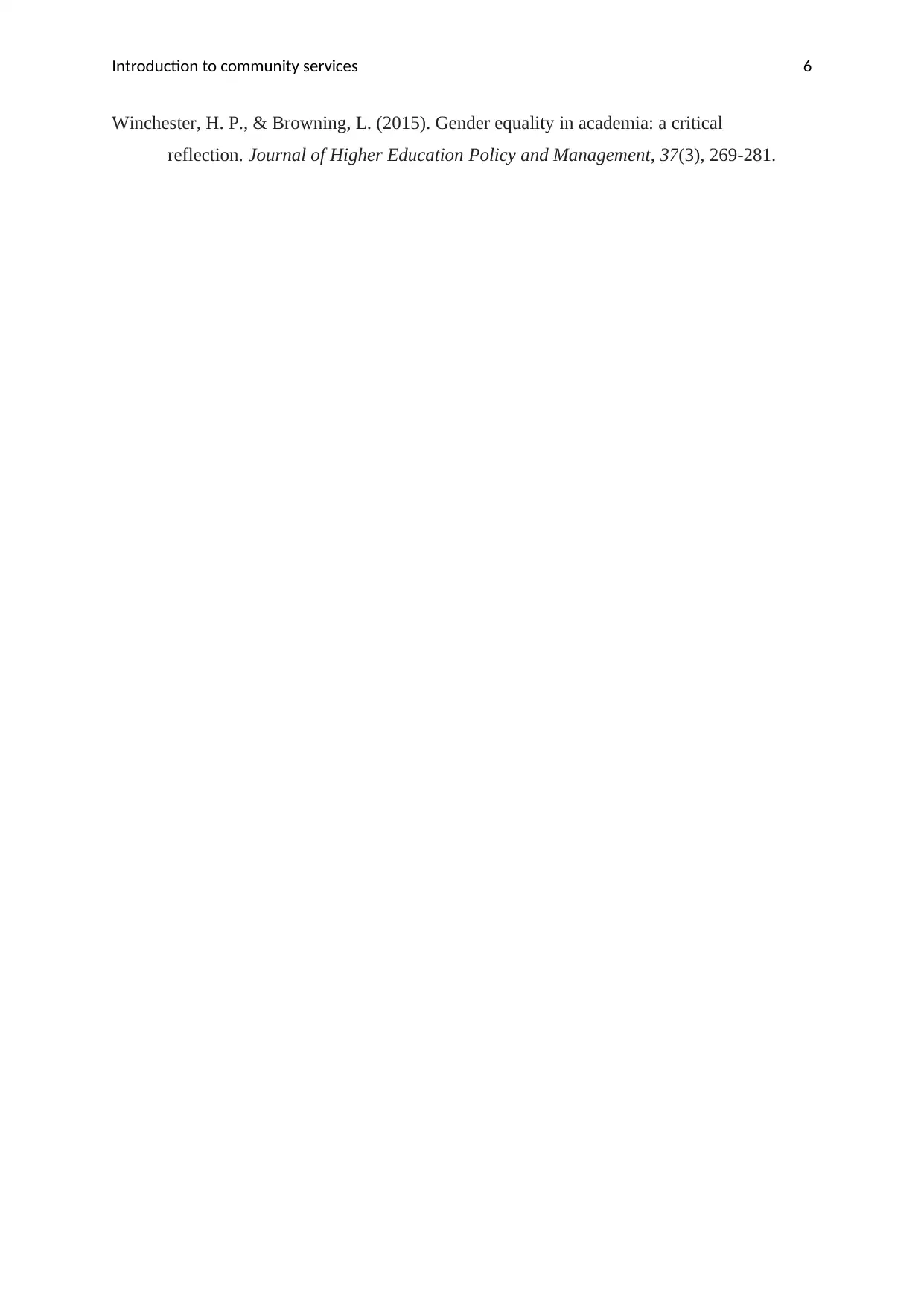
Introduction to community services 6
Winchester, H. P., & Browning, L. (2015). Gender equality in academia: a critical
reflection. Journal of Higher Education Policy and Management, 37(3), 269-281.
Winchester, H. P., & Browning, L. (2015). Gender equality in academia: a critical
reflection. Journal of Higher Education Policy and Management, 37(3), 269-281.
1 out of 7
Related Documents
Your All-in-One AI-Powered Toolkit for Academic Success.
+13062052269
info@desklib.com
Available 24*7 on WhatsApp / Email
![[object Object]](/_next/static/media/star-bottom.7253800d.svg)
Unlock your academic potential
Copyright © 2020–2025 A2Z Services. All Rights Reserved. Developed and managed by ZUCOL.





